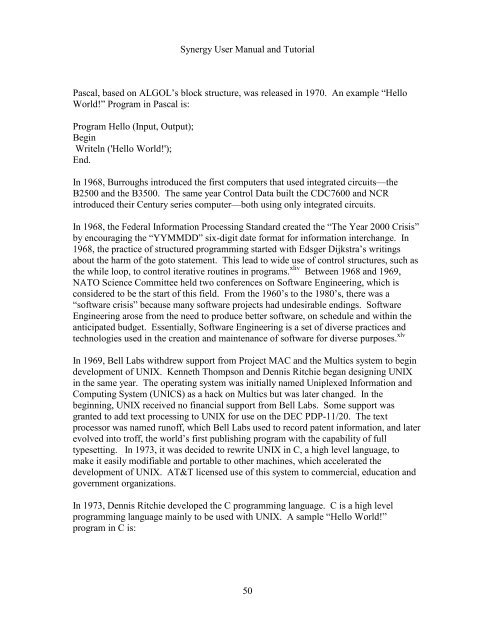Synergy User Manual and Tutorial. - THE CORE MEMORY
Synergy User Manual and Tutorial. - THE CORE MEMORY
Synergy User Manual and Tutorial. - THE CORE MEMORY
You also want an ePaper? Increase the reach of your titles
YUMPU automatically turns print PDFs into web optimized ePapers that Google loves.
<strong>Synergy</strong> <strong>User</strong> <strong>Manual</strong> <strong>and</strong> <strong>Tutorial</strong><br />
Pascal, based on ALGOL’s block structure, was released in 1970. An example “Hello<br />
World!” Program in Pascal is:<br />
Program Hello (Input, Output);<br />
Begin<br />
Writeln ('Hello World!');<br />
End.<br />
In 1968, Burroughs introduced the first computers that used integrated circuits—the<br />
B2500 <strong>and</strong> the B3500. The same year Control Data built the CDC7600 <strong>and</strong> NCR<br />
introduced their Century series computer—both using only integrated circuits.<br />
In 1968, the Federal Information Processing St<strong>and</strong>ard created the “The Year 2000 Crisis”<br />
by encouraging the “YYMMDD” six-digit date format for information interchange. In<br />
1968, the practice of structured programming started with Edsger Dijkstra’s writings<br />
about the harm of the goto statement. This lead to wide use of control structures, such as<br />
the while loop, to control iterative routines in programs. xliv Between 1968 <strong>and</strong> 1969,<br />
NATO Science Committee held two conferences on Software Engineering, which is<br />
considered to be the start of this field. From the 1960’s to the 1980’s, there was a<br />
“software crisis” because many software projects had undesirable endings. Software<br />
Engineering arose from the need to produce better software, on schedule <strong>and</strong> within the<br />
anticipated budget. Essentially, Software Engineering is a set of diverse practices <strong>and</strong><br />
technologies used in the creation <strong>and</strong> maintenance of software for diverse purposes. xlv<br />
In 1969, Bell Labs withdrew support from Project MAC <strong>and</strong> the Multics system to begin<br />
development of UNIX. Kenneth Thompson <strong>and</strong> Dennis Ritchie began designing UNIX<br />
in the same year. The operating system was initially named Uniplexed Information <strong>and</strong><br />
Computing System (UNICS) as a hack on Multics but was later changed. In the<br />
beginning, UNIX received no financial support from Bell Labs. Some support was<br />
granted to add text processing to UNIX for use on the DEC PDP-11/20. The text<br />
processor was named runoff, which Bell Labs used to record patent information, <strong>and</strong> later<br />
evolved into troff, the world’s first publishing program with the capability of full<br />
typesetting. In 1973, it was decided to rewrite UNIX in C, a high level language, to<br />
make it easily modifiable <strong>and</strong> portable to other machines, which accelerated the<br />
development of UNIX. AT&T licensed use of this system to commercial, education <strong>and</strong><br />
government organizations.<br />
In 1973, Dennis Ritchie developed the C programming language. C is a high level<br />
programming language mainly to be used with UNIX. A sample “Hello World!”<br />
program in C is:<br />
50

















